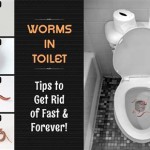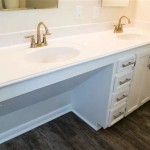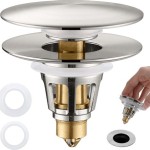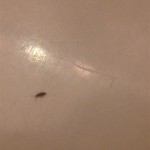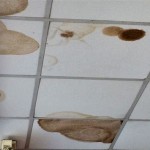Carpenter Ants in the Bathroom Sink: Why They're There and How to Get Rid of Them
Discovering carpenter ants in the bathroom sink can be disconcerting. While their presence might seem random, it often indicates a larger problem, possibly a hidden infestation and moisture damage within the structure of the home. Carpenter ants, unlike termites, do not consume wood for sustenance. Instead, they excavate it to create nesting galleries. This article aims to provide comprehensive information about why carpenter ants appear in bathroom sinks, the potential consequences of their presence, and effective strategies for eliminating them and preventing future infestations.
It’s important to understand that a few stray ants might simply be foraging for food and water, but a consistent presence, especially with visible wood shavings (frass), strongly suggests a nesting site nearby. Acting swiftly and decisively is crucial to prevent significant structural damage and costly repairs. Identifying the source of the infestation and addressing the underlying causes are paramount to long-term control.
Understanding Carpenter Ants: Identification and Habits
Carpenter ants are relatively large ants, typically ranging from ½ to ¾ inch in length. They are generally black or reddish-black, although coloration can vary depending on the species. A key identifying feature is their smoothly rounded thorax (the middle section of the ant's body), unlike some other ant species that have a more uneven or spiny thorax. They also possess a single node (a small, raised segment) between the thorax and abdomen.
Carpenter ants are social insects, living in colonies that can contain thousands of individuals. Colonies typically consist of a queen, workers, and reproductives (swarmers). The queen is responsible for laying eggs, while the workers perform tasks such as foraging, nest building, and caring for the young. Swarmers are winged reproductives that leave the nest to mate and establish new colonies. The presence of swarmers indoors is a strong indication of a mature, well-established infestation.
These ants are nocturnal, meaning they are most active at night. They prefer to nest in moist or decaying wood, although they can also infest dry wood, especially if it is adjacent to a moisture source. Common nesting sites include window frames, door frames, decks, porches, and areas around leaky pipes. The ants excavate galleries within the wood, creating smooth, clean tunnels. These tunnels weaken the wood and can lead to significant structural damage over time.
Carpenter ants do not eat wood. They feed on a variety of foods, including honeydew (a sugary substance produced by aphids and other insects), plant sap, fruit, and other insects. Inside homes, they are often attracted to sweets, meats, and other food scraps. Water is also essential for their survival, which explains why they are often found near sinks, bathtubs, and other water sources.
Why are Carpenter Ants Attracted to Bathroom Sinks?
The bathroom environment provides several attractants for carpenter ants. The most significant of these are moisture and readily accessible water sources. Leaky pipes, condensation, and inadequate ventilation can create damp conditions that are ideal for carpenter ant nesting. The sink itself provides a convenient source of drinking water. Even small drips or splashes can be enough to attract these ants.
Food sources, although less abundant than in a kitchen, can also contribute to the problem. Hair, soap residue, and other organic matter that accumulate in the sink drain can provide a limited, but still attractive, food source. Additionally, carpenter ants may be foraging from nearby areas, such as the kitchen or other rooms, and using the bathroom sink as a temporary water source during their travels.
The presence of conducive conditions, such as decaying wood around the sink, leaky faucets, or damp wall cavities, significantly increases the likelihood of a carpenter ant infestation. These conditions provide both nesting sites and a reliable source of moisture, making the bathroom a prime location for carpenter ant activity.
Plumbing penetrations - the spaces where pipes enter and exit walls and floors - are also typical entry points for carpenter ants. These areas notoriously accumulate moisture and often have small gaps that the ants can easily exploit. Ignoring these access points during preventative maintenance can dramatically increase the risk of an infestation.
Identifying and Addressing the Infestation: A Step-by-Step Approach
The first step in addressing a carpenter ant infestation is to accurately identify the problem. Confirm that the ants are indeed carpenter ants and not another type of ant or insect. Look for the key identifying features mentioned earlier, such as their size, color, and the shape of their thorax. Collect a specimen if possible and compare it to images online or consult with a pest control professional.
Next, locate the source of the infestation. This may require a thorough inspection of the bathroom and surrounding areas. Look for signs of carpenter ant activity, such as wood shavings (frass), which resemble coarse sawdust, and the presence of ants themselves. Pay close attention to areas where wood is exposed to moisture, such as around sinks, showers, toilets, and windows.
Inspect the surrounding walls and floors for signs of water damage, such as staining, discoloration, or soft spots. Use a screwdriver or other sharp object to probe the wood for hidden damage. If the wood is soft or easily penetrated, it is likely that it has been damaged by carpenter ants or other wood-destroying organisms.
Once the source of the infestation has been identified, take steps to eliminate the ants. This may involve using insecticidal baits, sprays, or dusts. Baits are generally considered the most effective option, as they allow the ants to carry the insecticide back to the colony, killing the queen and other members. Sprays and dusts can be used to treat localized areas, such as cracks and crevices where ants are likely to travel.
It is crucial to choose the appropriate type of insecticide for the specific situation. Some products are more effective against carpenter ants than others, and some may be harmful to humans and pets. Always read and follow the label instructions carefully when using any insecticide. If unsure about which product to use or how to apply it safely, consult with a pest control professional.
Beyond direct treatment, addressing the underlying causes of the infestation is essential for long-term control. Repair any leaks or water damage in the bathroom. Improve ventilation to reduce moisture levels. Remove any decaying wood or other materials that could provide nesting sites for carpenter ants. Seal cracks and crevices in walls and floors to prevent ants from entering the building.
For extensive infestations or where structural damage is significant, professional pest control services are highly recommended. Pest control professionals have the expertise, equipment, and access to more potent insecticides to effectively eliminate carpenter ant colonies. They can also provide valuable advice on preventing future infestations.
Preventative measures are crucial to keeping carpenter ants from returning. Keep the bathroom clean and dry. Repair any leaks promptly. Ensure adequate ventilation to reduce moisture levels. Seal cracks and crevices in walls and floors. Inspect the exterior of the building regularly for signs of carpenter ant activity. Trim trees and shrubs away from the building to prevent ants from using them as bridges to access the structure. Consider applying a preventative insecticide treatment around the perimeter of the building to deter ants from entering.
Regularly cleaning the sink and drain prevents the buildup of organic matter that can attract ants. Using drain cleaners periodically can help eliminate food sources and prevent clogs that can contribute to moisture problems. Making sure to wipe down surfaces after each use is a simple, yet effective, way to deter ants.

Boise Idaho Pest Control Pestcom

Niagara Pest Control Why Are There Carpenter Ants In The Bathroom

How To Stop Ants From Invading Your Bathroom Identification And Prevention Tips Tabor Pest Control

Boise Idaho Pest Control Pestcom

Ants In The Bathroom Get Rid Of Them With Bulwark Pest Control

Carpenter Ants Umn Extension

The Secret To Effective Ant Control For Pensacola Properties Ensec

Boise Idaho Pest Control Pestcom

8 Tips On How To Get Rid Of Ants In The Bathroom Sink Kitchen

How To Get Rid Of Carpenter Ants Best Ways Kill
Related Posts
